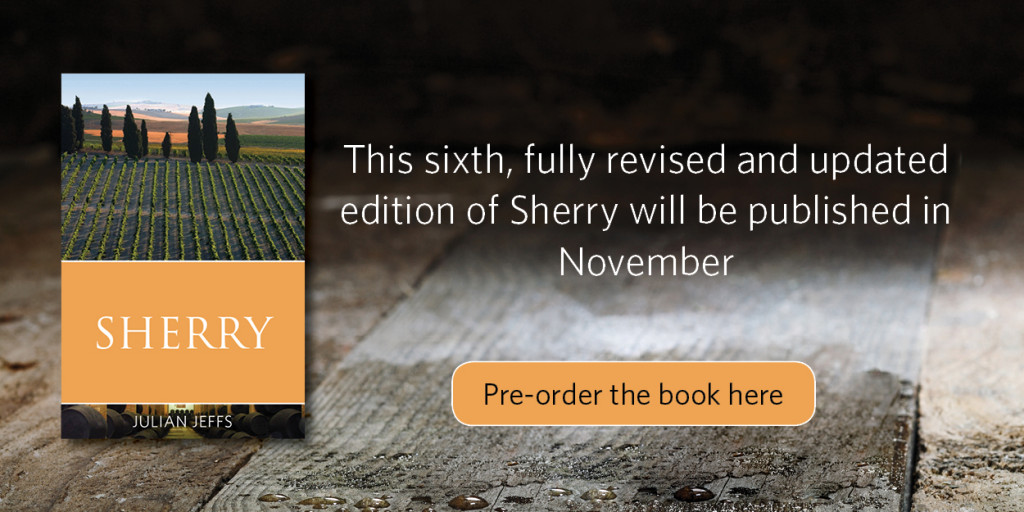The Infinite Ideas interview with Julian Jeffs
12 November 2014 by Catherine Holdsworth in Sherry, Wine and spirits
 Julian Jeffs is the author of Sherry, sixth edition, available on 20th November. We’re all very excited about this and so Julian came along to discuss the sherry wine trade and his thoughts for the future of the drink.
Julian Jeffs is the author of Sherry, sixth edition, available on 20th November. We’re all very excited about this and so Julian came along to discuss the sherry wine trade and his thoughts for the future of the drink.
Why isn’t sherry produced anywhere else?
Sherry, like every other wine, is the product of vines and vineyards. The Palomino Fino grapes that produce sherry can be grown elsewhere and are found in various parts of Spain. In other places they produce rather inferior table wines and nothing in the least resembling sherry. The factors enabling these vines to yield sherry are the calcium-rich albariza soil and the climate, a combination unique to the sherry area.
What have been the biggest changes in the production of sherry over the years? Why do you think this is?
In the last sixty years practically everything has changed for two reasons. The first is the enormous increase in the cost of labour and the second is a much more profound knowledge of wine science: of what goes on while the juice of the grapes is being transformed into wine. The increased cost of labour has done away with the old gangs of workmen who used to run the bodegas in a very labour-intensive way. Mechanisation and efficiency became essential if sherry was to survive. And wine science means that diseased and defective wines have practically disappeared while the average quality of the wine has increased correspondingly.
In Sherry you’ve written a lot about the history of the drink, but what do you think lies ahead in the world of cognac; does it face challenges or do you predict a boom?
The history of sherry has been one of boom and bust. This is partly owing to the pendulum of fashion and partly brought about by the shippers who in times of boom go for volume and ship very poor wines at very low prices. This rightly brings them into disrepute. Its future can only lie in its being recognised as one of the world’s great wines, which it undoubtedly is. Another difficulty lies in the absence of advertising. The leading brands, which had to be of above average quality, were widely advertised but now that sherry is no longer profitable this is impossible. The market is being built up again for good quality wines and yes, I think here will be another boom, but the next peak may be many years away.
Do you think global warming has affected the production of sherry?
The only effect global warming has had on sherry so far is the advance the date of the vintage. This year it started on August 11th and ended on September 15th, about a fortnight earlier that it used to. The grapes are picked at the right degree of ripeness and it does not appear to have affected the quality in any way. It will be slightly easier, though, to make sweet wines.
Do you think that technology has generally been a good thing or a bad thing for sherry?
Technology has undoubtedly been a good thing in several different ways. Owing to the scarcity and cost of vineyard labour, without modern methods of cultivation and mechanical harvesting in particular, it is doubtful if the sherry vineyards could continue. In the bodegas extraction of the must from the grapes is now very well controlled so that the highest possible quality is obtained, with oxidation and excessive pressure avoided. The must is then be fermented under carefully controlled conditions and the poor quality or even defective wines that were once only too common have now virtually been abolished. I cannot think of any way in which technology has operated to the detriment of the wines save perhaps for the fact that it enables the shippers to pander to the taste for light coloured and limpid wines with too much taken out of them, leading to a diminution of flavour and character. But that seems to be the public taste.
Sherry is often regarded as an old-fashioned tipple; how would you convince today’s drinkers that it’s worth trying?
By giving them a glass or two to drink and telling them what to look for. I have given tutored tastings for sixth formers at schools and undergraduates at university who have been amazed and delighted when shown what good sherry really tastes like. The lesson that it tastes good with food is also being learned and shown by the success of tapas bars. The intelligent young can enjoy classical wines just as they can classical music.
Sherry-tasting is quite a specialised skill. How did you get into it – were you a natural or did you have to learn?
Some people have more sensitive palates and noses and better memories for flavours than others. Those who are favoured in this way make the best tasters, and there are a very few who do not seem to have these gifts at all, so almost anyone can enjoy the subtleties and beauties of wine. It does not come naturally, though, and has to be taught by suggesting to a young taster the things he or she should look for and to identify the differences between the various wines. I was fortunate in having a father who was a knowledgeable wine lover and who gave me my first lessons. Like most teenagers I was something of a rebel and saw there were two alternatives: I could reject wine, but that did not happen because I soon liked it enormously, or I had to learn more about it than my father. I chose the latter course to his amusement and gratification.
Can you tell us about the worst sherry drink you have ever tasted?
In 1956 I was crossing the Channel in a French ferry. Before lunch I went to the bar and optimistically asked for a glass of sherry. The barman told me he only had ‘French sherry’ so I ordered a glass. I have no idea what it was but it was memorably horrible. About twenty years later I was on holiday in Italy and saw a bottle of an excellent fino behind the bar. The colour looked wrong but I ordered a glass out of curiosity. I gathered it had been there, open, for two or three years and it had become brown. My curiosity was satisfied but again it was horrible.
Who is the greatest character you have met during your long career as a sherry expert? Can you tell us about him/her?
The Sherry country has always been full of characters and happily they still abound. I have met enough to fill a small book. But if I have to select just one it would be Manuel María González-Gordon, Marqués de Bonanza. He should be the subject of a biography not just a paragraph. I got to know him soon after I arrived in Jerez the first time in 1956 when he was head of González-Byass. He was tall, slightly stooping, as tall men often are, good looking, extremely short-sighted and never put on show any sign of his aristocratic birth, wealth or position. He drove about in an old Austin Seven. He was a scholar and a gentleman, friendly to all, young or old, saint or sinner. Drinking sherry with him was an education. To everyone he was Uncle Manolo. As a scholar he knew more about sherry than anyone and wrote the classic book about it. In his old age he laid the foundations for the scientific investigation of sherry that have given rise to its modern enology. Once when I was there the city pulled down its old gaol (which was a pity as it was in a rather beautiful old convent) and built a grand new one. I remarked on this to a friend who said “Yes, and there are only two people inside it: a gipsy who stole a hen and Uncle Manolo trying to help him.” A great friend of the United Kingdom, he was appointed hon. K.B.E. He was born a sickly baby and the doctors despaired of his life but his mother gave him sherry and he survived to die in 1980 aged 93.
Other than sherry what is your favourite drink – not necessarily alcoholic – and why?
I enjoy drinking all sorts of things ranging alcoholically from water to old brandy and taking in tea and coffee. I would miss them all, particularly coffee for breakfast. I enjoy drinking all the classic wines and several obscure ones but apart from sherry perhaps the one I would miss most (though by a very small margin over several others) would be claret.

